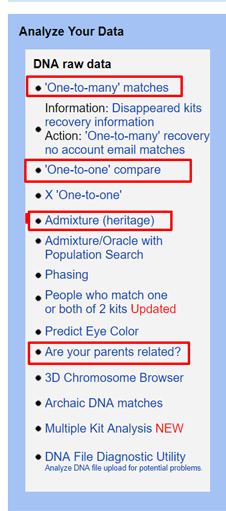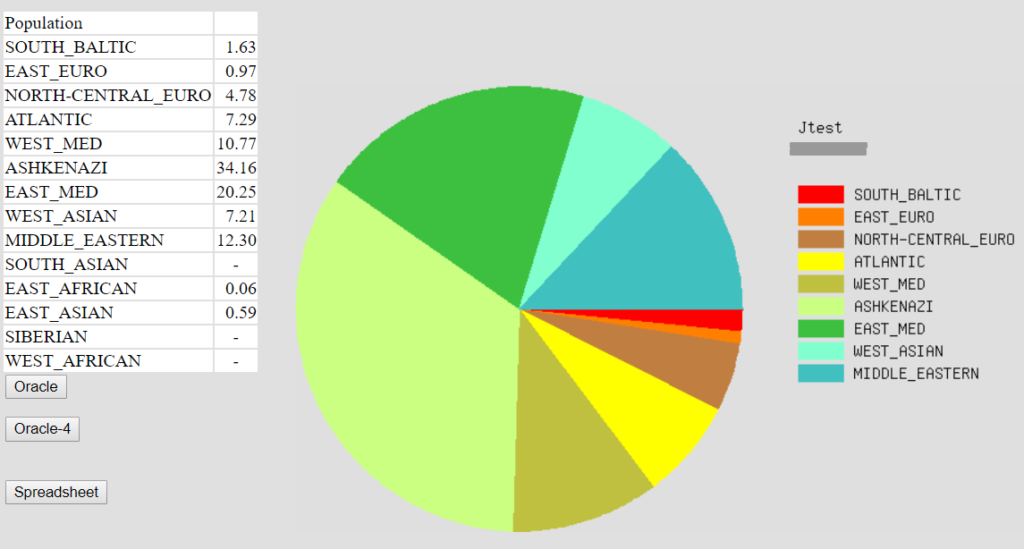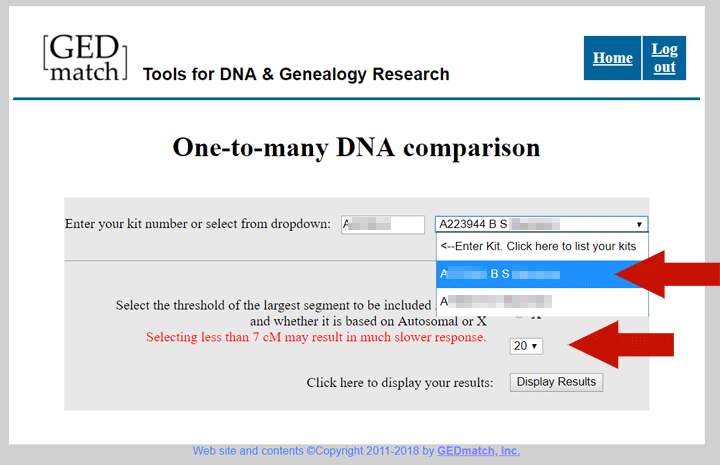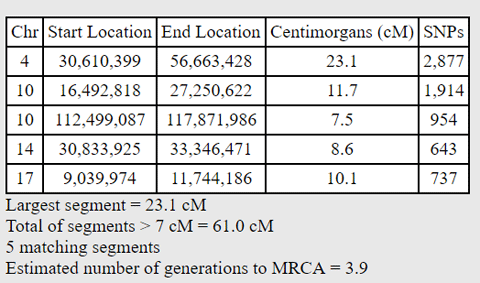UPDATE 18-AUG-2019: Although many of the concepts in this post are good to know and the ethnicity calculators are not changed. The GEDMATCH site has had a facelist and hes been replaced by what was previously called the GENESIS site. So better to read the following posts:
- https://blog.kittycooper.com/2019/02/genesis-basics-gedmatch-reinvented-part-1/
- https://blog.kittycooper.com/2019/03/the-beta-one-to-many-tool-genesis-basics-ii/
If you and a relative have tested your DNA at different companies, you can compare your results at a free third party site – GEDmatch.com – which also has many additional, useful tools for analyzing your DNA and looking at match lists. Learning to use those tools may take some time as they are not intuitive, so I am writing this post to help a friend, Barbara, start to use them.
 The GEDmatch site can be intimidating for the less computer savvy. Like most any place on the web, you have to register by creating a username (your email) and password . Click here for more details on registering in my GEDmatch Basics presentation starting on slide 2. Please do not be put off by the extensive new Terms of Service you have to agree to. GEDmatch has to meet the current EU requirements plus they need to warn you that your DNA could be used to identify a victim or catch a criminal among your relatives.
The GEDmatch site can be intimidating for the less computer savvy. Like most any place on the web, you have to register by creating a username (your email) and password . Click here for more details on registering in my GEDmatch Basics presentation starting on slide 2. Please do not be put off by the extensive new Terms of Service you have to agree to. GEDmatch has to meet the current EU requirements plus they need to warn you that your DNA could be used to identify a victim or catch a criminal among your relatives.
Once you have a username and password and log in, you are presented with a home page which, again, is not very user friendly. The first task, which we already did Barbara, is to upload your DNA test data. Start with this slide https://slides.com/kittycooper/gedmatch-10-13#/9 for the details of how to upload and manage your DNA results, known as kits, to GEDmatch.
The image to the left shows the big blue box, called “Analyze Your Data,” which you can find on the right side of your GEDmatch home page. I have put a red box line around the functions that I find the most useful. One of the first things I do for a newly uploaded kit is check if the parents are related (yours were not Barbara, nor Martin’s).
Once your kit is uploaded, it still has to be “tokenized” which you can think of as being put into chunks for the template they use for comparisons; this can take 24 hours or so. While you wait to be able to use your kit to look for matches, you can play with the ethnicity tools. Please remember that figuring out the groups you descend from is a science still in its infancy and far from accurate yet, other than in the broad strokes.
Start with Admixture (heritage). For most Europeans, the Eurogenes calculator is best and the default K13 is fine, but for those of us with mainly Northern European ancestors, K12 is better. I have a whole presentation on just these calculators at https://slides.com/kittycooper/gedmatch#/
 Although its creator has disavowed the Eurogenes Jtest calculator for listing your Jewish percentage (click here for his article), I find that if you add up all the obvious ethnicities: Ashkenazi, Western_Med, Eastern_Med, West_Asian, and Middle_Eastern, it is not that far off. The Jtest image above is from Martin, the only person I have ever seen AncestryDNA
Although its creator has disavowed the Eurogenes Jtest calculator for listing your Jewish percentage (click here for his article), I find that if you add up all the obvious ethnicities: Ashkenazi, Western_Med, Eastern_Med, West_Asian, and Middle_Eastern, it is not that far off. The Jtest image above is from Martin, the only person I have ever seen AncestryDNA call 100% European Jewish; most of my jewish friends come out between 87% and 98% there.
Click here for the creator, Davidski’s Eurogenes blog posts on Gedmatch. Two important take-aways for me are that his ancestral clusters are much further back than the main companies and any ethnicity of 1% or smaller is likely noise.
Once your kit has tokenized, you can start using the most important tool, the One-to-many compare function which will compare your kit to all the kits in the database and then list your closest DNA relatives.
One-to-many is the workhorse of DNA matching for us genealogists. When you click on those words in the blue box you get a form which lets you pick which of your kits to use or type in another one. There is also a default number for the largest segment which is set to 7. Change that to 20 if you are jewish, else to 10 or even 15.

Below is an image of your top One-to-many results, Barbara, with the first column (kit number) and last two columns (name or pseudonym then email) cut off for privacy. Note that the kit numbers start with a letter which tells you where they tested so A is Ancestry, T is Family Tree DNA, M is 23andMe, and H is MyHeritage. Warning, Ancestry kits will typically have more matching DNA with you here at GEDmatch, because Ancestry
removes segments that it considers common in the population in their matching algorithm.
The red arrows added by me to the image are showing two important spots on the report. One is showing where you can click the underlined A to get a one-to-one comparison with that match. The one-to-one will show you exactly where you match, which chromosome and location.
Barbara, below is the one to one “position only” for your best match, *FT etc, who is clearly in the 3rd/4th cousin range.
None of the matches listed in the One-to-many above are close relatives as they share too few total cMs. All are about 4th cousins or so. Click here for the DNA Painter calculator which you can use to see the possible relationships for a specific total. However please remember that after second/third cousins, DNA inheritance gets more and more random and the total cM number cannot tell you the specific relationship, just the likely ones. I usually tell people to start with those people who share more than 100cM.
The second red arrow shows where to sort by largest segment which I often suggest to jewish friends that they do. Why? Because so many people will match you at a 4th cousin level who are really 6th cousins three times over or the like, due to much intermarriage (endogamy). Therefore we need the matching DNA segments to be large for those real 3rd and 4th cousins whose common ancestors might be findable. My recommendation is one segment greater then 20cM and another greater than 10cM and about 5 or 6 segments. That is just a guideline, not an absolute, but works well among jewish matches.
Start with this slide – https://slides.com/kittycooper/gedmatch-10-13#/25 – to see more about how to use the One-to-many function. Plus this blog post http://blog.kittycooper.com/2016/06/gedmatch-tools-2016/ explains the headings on the One-to-many report.
Some of your matches will have family trees posted. Read this post for more about that http://blog.kittycooper.com/2017/03/family-trees-are-now-linked-to-from-the-gedmatch-tier-1-one-to-many/.
My recommendation is to contact just your best matches at first. If you have other family members tested and so know which line the match is related on because of who they match, tell them! Be specific in your email as to where your family lines are from and include a link to your tree. Best is to add your tree to the collaborative world tree at WIKItree then add your GEDmatch kit number to your profile there with a public biography and tree (dates are still private for the living). If you do all that, a link to your tree will appear next to your kit number in your matches One-to-many. Alternately, you can upload your tree to GEDmatch itself which also puts a link next to your kit number, but be sure to privatize it first.
There are many advanced GEDmatch posts on this blog. They are listed on the DNA advanced menu under Gedmatch posts for your further reading, eventually.
One problem is that newer DNA tests like 23andme since August 2017 or LivingDNA can only be uploaded to GEDmatch’s in progress site: Genesis, because the underlying chip for these DNA tests is different from the previous kits used. My screen shots are not accurate for Genesis but the concepts are. I look forward to this post being outdated very soon when the conversion to that site is complete. If you have kits at GEDmatch they are automatically being migrated to Genesis and your same login will work there.
Have fun Barbara!


Thanks so much for sharing the information.
I also find the routine ” People who match one or both kits” as helpful….
I run the routine and look at the list of common matches, looking for anyone who’s connection to me is known…..
That will give me some idea of which side of my family the match is on….
Certainly not a perfect process, yet every hint helps.
I totally agree Dennis, but i was trying to keep the post short and simple. Using that routine is very useful when you have cousins on a specific line tested.
I was just told that Gedmatch does not take results or data from the Y-dna test. Is this correct? I am pretty sure I have uploaded my cousin’s and he has matches ???
Sorry it is and always has been autosomal only at gedmatch
Maybe you are thinking of Y-search? It was a public site that took Y results but it has been shut down.
Pingback: This week’s crème de la crème — June 30, 2018 | Genealogy à la carte
I have uploaded family to Gedmatch some time ago but haven’t gotten much further than the one-to-one tool. Will you be exploring the other available tools with us?
Last question: How often should one update their raw data? Every month we receive more and more cousin matches as Ancestry and FTDNA continue their price war.
Polly –
The one-to-many is the most important tool for finding new relatives. if you look through my past posts on GEDmatch, you will find more details on most of the tools:
http://blog.kittycooper.com/tag/gedmatch/
Or click on DNA Advanced above and then put your mouse on GEDmatch to see menu items for the most important tools.
If you have a family group, I recommend making a tag group or two and then use the multi kit analysis
http://blog.kittycooper.com/2017/03/gedmatch-tag-groups-plus-new-one-to-many/
You NEVER need to update your raw data as it does NOT CHANGE. It is a reading of a sample of your DNA. What changes is only the match lists. This slide shows you what the raw data looks like:
https://slides.com/kittycooper/dnaresults-25#/2
Ok
May I ask something? I did upload raw 23andMe data via the Genesis option–BUT I HAD UNZIPPED IT without realizing they prefer the zipped file. Anyway, the system took the data and issued a Kit Number starting with “CE” Problem is that it was over a week ago and I am still getting “kit not found”. This is in spite of seeing all other signs as “go” (the little red checkmark, for instance)
I don’t want to have to go through another company for another DNA test but was surprised to hear GEDMatch prefers Ancestry for technical reasons.
Anyway, I wonder if something is wrong and I need to start over . . .
Yes, start over with the zipped file
Hi Kitty:
I am trying to compare two kits on Gedmatch. One is a regular gedmatch kit from Ancestry. THe other is from 23andme, and I just got the results yesterday. I had to upload them to the Genesis Gedmatch because they are from 23andme. But I don’t see a way to compare the two at the same time. If I’m in genesis, it doesn’t see the regular Ancestry kit. And if I’m in regular gedmatch, it doesn’t see the 23and me Genesis kit. How can I compare these two kits.
So sorry I missed this question K, I hope you figured out to upload the Ancestry kit to Genesis. By now you can compare them at genesis without uploading again
How long does it usually take to tokanize? Its been over 4 days. Thank you for your help. Jeanette
Jeannette,
That is too long. If it is a 23and me kit it is not compatible with Gedmatch, you have to upload to Genesis. In fact soon all uploads will have to be to Genesis
That was from genesis. It was just the line from one lady. Ill try it again.
Largest Seq. is 60
total cMs 485.5
Gen 2.4
overlap 72255
she is 80 yrs old an was adopted. I was also adopted .I know my birth mother but not my father, it seem to me she is a very close relative? just really dont know how to read all this. Thank you for your help. If you can.
Look it up at DNApainter’s calculator
https://dnapainter.com/tools/sharedcmv4
Assuming you are much younger than 80 the most likely relattionship is 1C1R; that would mean a parent of your Dad’s is a sibling to one of her parents.
There is much help for adoptees on this blog. Read this which has many links to resources:
https://blog.kittycooper.com/dna-basics/help-for-adoptees/
OH gosh. I replied to the wrong reply. LOl sorry. Not sure where I posted the last one. It did finally tokanize. Now you might be confused. sorry.
I haven’t been on the GedMatch site in awhile and found out both mine and
my husband’s kits have dissappeared. I was going to ask to be relinked but read that you have to go to support and ask to be relinked.
The problem is, I cannot find the “Support” page. I need step by step instructions on what to do to get our kits to show up.
Thanks,
Jenny Sanders
Jenny,
All of Gedmatch has moved to Genesis so log in there, same user is and password. If your kits ar not there, send an email to Gedmatch at gmail with the email you used to register and the old kit numbers… Or just upload them again to gemesis
Hello Kitty, thank you for your blog post, it’s very helpful. I do have a broad question for you. How accurate do you think DNA testing is in general from these companies, specifically 23andMe? Can it be wrong? Do you know anyone who has had a wrong DNA result? I’m particularly speaking of sibling, 1/2 sibling, 1st cousin. This is all very overwhelming, since it seems who I thought was my dad isn’t and I now have a 1/2 brother. Thank you!
Dear leafy,
Predicting close relatives is very accurate although there is some overlap between categories. Full siblings are unmistakable in their DNA see http://blog.kittycooper.com/2016/04/full-versus-half-sibling-dna-matches/
I am so sorry, hugs
At GEDMATCH when I use one to one and tick FIR it shows = 1020.1 cM (28.444 Pct) but when I don’t it finds only HIR totalling 2766 cM – this is comparing my sister’s kit and mine. And some of the long green bars meaning full match have black bars under all or some…and 4 chromosomes have no match at all.
Could we be 3/4 siblings – I know my sister is from the dad we always knew but opinion has been that I am from his only sibling, his brother, who lived with us for years until I was about 6.
Going in the hospital till end of April, but will try to monitor emails if possible.
You are full siblings with that many FIRs and HIRs, same parents.
How do you get the cm limit to be below 7 for the One to Many on genesis. I choose 5, but it still will not go below 7
Ken –
You can’t and I would not advise doing that. Segments of less than 7cM are likely to be false.
You might sometimes lower it on the one to one but never on the one to many. Too many false matches would be listed.
Used 23 and Me. 1100 match results, DO NOT know any of them.
One of the closest says 1st cousin, 25 segments, 936cM, half identical.
Does this tell me anything? Like I said, I do not know any of these people.
also says shred dna 12.6%
shared
Nkm –
Tha amount is likely a half niece/nephew or a few other possibilities including 1st cousin… check the numbers here
https://dnapainter.com/tools/sharedcmv4
So if your father or uncle had a child out of wedlock that they did not know about, this person could be the child of that child …
Make your family tree. I recommend using WIKItree as it is a collaborative world tree with many DNA features. Likley your (great)grandparents are already there, so less work to add your branch.
See if any of your closer matches fit on that tree. If they do not, you might be adopted, switched in the hospital, or … get some cousins on each side to test to help you sort this out
As a newbie I have a question. Maybe the answer is out there but I fail to find it. Anyway here goes.
Can you explain what the colors mean on the chromosome charts on Gedmatch Genisis? There are varying amounts of green, red, yellow and blue. All I know is that it relates to amounts of centimorgans.
Sadly they are not consistant. On some charts green is the best and red the worst. On others it is the other way around. Typically the colors indicate how close or far the matches are and intensity plus gradations do the in between.
Is there a specific report you are asking about?